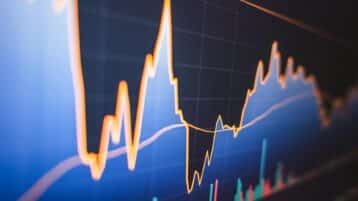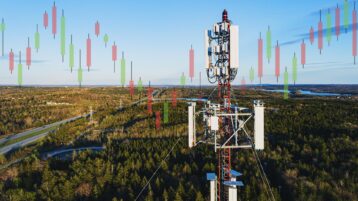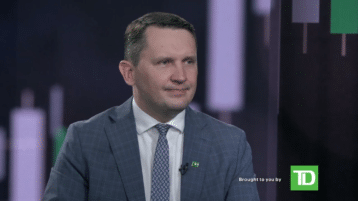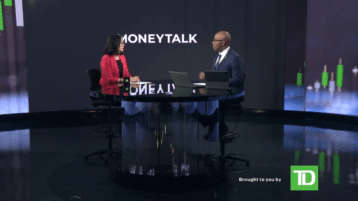Institutional investors have been steadily increasing their allocation to alternative investments such as real estate and infrastructure over the last decade. Should retail investors follow suit? Kim Parlee speaks with Jeff Tripp, Managing Director, Head of Alternative Investments, TD Asset Management.
Print Transcript
[MUSIC PLAYING]
- I know we're talking about some specific things you're seeing right now. And I think we'll start with commercial real estate. I know before we talked about transit hesitancy in terms of the attractiveness of the commercial real estate space. So what are you seeing right now? And what are you looking for?
- Hi, Kim. Thanks for having me on again. Transit hesitancy is-- I mean, I think it's an interesting phenomena. And no question when the pandemic set in around the world, we saw ridership drop off or transit usage drop off significantly. There's the fear element and really nowhere to go. So I think what we are seeing now with vaccinations starting to take hold with some of the fear element, the psychological and behavioral parts of the human behavior cannot be overstated.
So that comfort level is starting to return. And what that means is people are a little more comfortable getting back on to transit. And that may be to go to work. It may be as cultural and entertainment venues start to reopen. So there are places to go. The fear is subsiding.
Why is that so important for real estate? In our view, the proximity of real estate, whether it's office, retail, or residential-- the proximity on transit is so important because in major cities, transit moves billions of people a day. So it makes that real estate more accessible.
In our view, it attracts tenants, commercial tenants, because they want to be on transit. They want to make it easy for their employees, customers, and consumers to get there. So it's critically important. And as ridership returns, we think that that will pronounce the importance of that proximity to transit for real estate.
- Interesting. And, obviously, that's something that probably was a little less out of favor because of COVID. But one thing that was in favor-- and I'm curious about valuation-- is industrial spaces. We all know that we're basically attached to Amazon and all the warehouse-type spaces and what that means. So what are you seeing with industrial properties? I mean, are there still opportunities in the space?
- Well, there's no question that the pandemic has accelerated some of the trends around e-commerce and, of course, online shopping. People need to get their goods in some fashion. And that's typically shipped from a warehouse. So e-commerce fulfillment has definitely underpinned demand for industrial. And that is a global phenomenon. We're seeing it all around the world.
And I think there's still a supply and demand imbalance in most major markets in that you've got that tremendous demand driver, but the pace at which new industrial can be built to keep up with that demand is a little bit slower. So you have that imbalance, which obviously drives increasing rental rates and then, on the value side, very strong investor demand for industrial properties, which is promoting strong pricing and low cap rates.
As we think about our industrial holdings, one of the areas that we really focus on is building industrial. We're able to achieve a yield premium by building from greenfield and enhance returns over what we could achieve if we were buying assets in the open market.
If we zeroed in on one part of the world where we think there are opportunities, we'd look at Australia as an example. So Australia's been a little slower to adopt e-commerce versus other parts of the world. So we're seeing the demand start to pick up there. And like other major markets, the major markets in Australia have had those supply challenges. So there is rental rate growth. But we still feel it's early days, so that the pricing is still attractive relative to what we can achieve in other areas.
- Interesting. What's happening in retail? Because I mean, is this an interesting-- are you seeing more distressed assets because of what's been happening with COVID or not? What's happening there?
- Yeah, not a lot of distress-- in the Canadian context, very, very little. And frankly, the pandemic is not a liquidity crisis. It's a health crisis. So we've not seen a lot of distress. What we are seeing is an acceleration of trends around retail. So we've talked about e-commerce. Obviously, that has impacts on bricks-and-mortar retail. But that's not a new trend. That's been accelerated to some degree by the pandemic, but it is an acceleration.
So what does that mean? In some cases, we are seeing some expansion of yields. But it's important to acknowledge that there's variation within the retail space. So enclosed shopping centers around the world have been a little more stretched from an income and valuation perspective, particularly in markets where they were regulated to be closed, versus open-air shopping centers that are typically more necessity based, grocery driven, that type of thing. We've seen more resilient income there, and values have held up a little bit better.
All that said, we do think that retail has maybe been hit a little bit hard. So I think if underwriting is robust, we do still see opportunities to properly acquire retail that can be accretive.
- It's fascinating how much is going on in the space right now. And I've only got a couple of minutes, Jeff, but I do want to touch on global infrastructure. I was taking a look at some of the numbers, your portfolio-- $1.6 billion in assets under management, seven platform investments, 300 underlying projects when you know the space well. And I'm specifically interested in what's happening with the switchover I see from the ESG side of things. We're moving away from carbon-based fuels into new infrastructure. Does that just bring a whole new world of opportunity?
- Yeah, I think that's fair to say, Kim. We see the current era as somewhat of a reset in that infrastructure investors are looking to place capital in green or sustainable projects where, historically, capital may have flowed into older-generation assets like coal-fired power plants as an example. Renewable projects are very much strategic holdings in our portfolio. And we're overweight in the space, so we certainly like the space.
From an example perspective, one of our key holdings is a project called Rabbalshede Kraft, and that's an onshore wind developer owner and operator based in Sweden. And that platform generates over 250 megawatts of renewable energy. And we've got a development pipeline to add another 750 megawatts, so quite significant. And we love the investment because it provides stable and predictable long-term returns and cash flows. You've got that strong operating performance, and then you've got the growth drivers associated with the development pipeline.
- Lots going on, and it's an interesting time. Jeff, always a pleasure having you with us. Thanks so much.
- Thank you, Kim.
[MUSIC PLAYING]
- I know we're talking about some specific things you're seeing right now. And I think we'll start with commercial real estate. I know before we talked about transit hesitancy in terms of the attractiveness of the commercial real estate space. So what are you seeing right now? And what are you looking for?
- Hi, Kim. Thanks for having me on again. Transit hesitancy is-- I mean, I think it's an interesting phenomena. And no question when the pandemic set in around the world, we saw ridership drop off or transit usage drop off significantly. There's the fear element and really nowhere to go. So I think what we are seeing now with vaccinations starting to take hold with some of the fear element, the psychological and behavioral parts of the human behavior cannot be overstated.
So that comfort level is starting to return. And what that means is people are a little more comfortable getting back on to transit. And that may be to go to work. It may be as cultural and entertainment venues start to reopen. So there are places to go. The fear is subsiding.
Why is that so important for real estate? In our view, the proximity of real estate, whether it's office, retail, or residential-- the proximity on transit is so important because in major cities, transit moves billions of people a day. So it makes that real estate more accessible.
In our view, it attracts tenants, commercial tenants, because they want to be on transit. They want to make it easy for their employees, customers, and consumers to get there. So it's critically important. And as ridership returns, we think that that will pronounce the importance of that proximity to transit for real estate.
- Interesting. And, obviously, that's something that probably was a little less out of favor because of COVID. But one thing that was in favor-- and I'm curious about valuation-- is industrial spaces. We all know that we're basically attached to Amazon and all the warehouse-type spaces and what that means. So what are you seeing with industrial properties? I mean, are there still opportunities in the space?
- Well, there's no question that the pandemic has accelerated some of the trends around e-commerce and, of course, online shopping. People need to get their goods in some fashion. And that's typically shipped from a warehouse. So e-commerce fulfillment has definitely underpinned demand for industrial. And that is a global phenomenon. We're seeing it all around the world.
And I think there's still a supply and demand imbalance in most major markets in that you've got that tremendous demand driver, but the pace at which new industrial can be built to keep up with that demand is a little bit slower. So you have that imbalance, which obviously drives increasing rental rates and then, on the value side, very strong investor demand for industrial properties, which is promoting strong pricing and low cap rates.
As we think about our industrial holdings, one of the areas that we really focus on is building industrial. We're able to achieve a yield premium by building from greenfield and enhance returns over what we could achieve if we were buying assets in the open market.
If we zeroed in on one part of the world where we think there are opportunities, we'd look at Australia as an example. So Australia's been a little slower to adopt e-commerce versus other parts of the world. So we're seeing the demand start to pick up there. And like other major markets, the major markets in Australia have had those supply challenges. So there is rental rate growth. But we still feel it's early days, so that the pricing is still attractive relative to what we can achieve in other areas.
- Interesting. What's happening in retail? Because I mean, is this an interesting-- are you seeing more distressed assets because of what's been happening with COVID or not? What's happening there?
- Yeah, not a lot of distress-- in the Canadian context, very, very little. And frankly, the pandemic is not a liquidity crisis. It's a health crisis. So we've not seen a lot of distress. What we are seeing is an acceleration of trends around retail. So we've talked about e-commerce. Obviously, that has impacts on bricks-and-mortar retail. But that's not a new trend. That's been accelerated to some degree by the pandemic, but it is an acceleration.
So what does that mean? In some cases, we are seeing some expansion of yields. But it's important to acknowledge that there's variation within the retail space. So enclosed shopping centers around the world have been a little more stretched from an income and valuation perspective, particularly in markets where they were regulated to be closed, versus open-air shopping centers that are typically more necessity based, grocery driven, that type of thing. We've seen more resilient income there, and values have held up a little bit better.
All that said, we do think that retail has maybe been hit a little bit hard. So I think if underwriting is robust, we do still see opportunities to properly acquire retail that can be accretive.
- It's fascinating how much is going on in the space right now. And I've only got a couple of minutes, Jeff, but I do want to touch on global infrastructure. I was taking a look at some of the numbers, your portfolio-- $1.6 billion in assets under management, seven platform investments, 300 underlying projects when you know the space well. And I'm specifically interested in what's happening with the switchover I see from the ESG side of things. We're moving away from carbon-based fuels into new infrastructure. Does that just bring a whole new world of opportunity?
- Yeah, I think that's fair to say, Kim. We see the current era as somewhat of a reset in that infrastructure investors are looking to place capital in green or sustainable projects where, historically, capital may have flowed into older-generation assets like coal-fired power plants as an example. Renewable projects are very much strategic holdings in our portfolio. And we're overweight in the space, so we certainly like the space.
From an example perspective, one of our key holdings is a project called Rabbalshede Kraft, and that's an onshore wind developer owner and operator based in Sweden. And that platform generates over 250 megawatts of renewable energy. And we've got a development pipeline to add another 750 megawatts, so quite significant. And we love the investment because it provides stable and predictable long-term returns and cash flows. You've got that strong operating performance, and then you've got the growth drivers associated with the development pipeline.
- Lots going on, and it's an interesting time. Jeff, always a pleasure having you with us. Thanks so much.
- Thank you, Kim.
[MUSIC PLAYING]


























